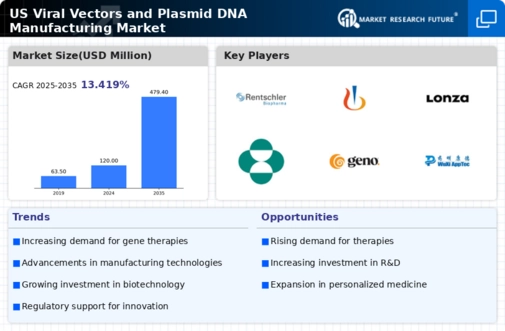Growing Demand for Gene Therapies
The increasing prevalence of genetic disorders and chronic diseases in the US is driving the demand for innovative treatment solutions. Gene therapies, which utilize viral vectors and plasmid DNA, are emerging as viable options for addressing these health challenges. The viral vectors-and-plasmid-dna-manufacturing market is witnessing a surge in demand, with estimates suggesting a growth rate of approximately 15% annually. This trend is likely to continue as healthcare providers and patients seek more effective therapies, thereby propelling the market forward. Furthermore, advancements in gene editing technologies, such as CRISPR, are enhancing the efficacy of these therapies, further stimulating interest and investment in the viral vectors-and-plasmid-dna-manufacturing market.
Increased Focus on Preventive Medicine
The shift towards preventive medicine is reshaping the landscape of healthcare in the US, with implications for the viral vectors-and-plasmid-dna-manufacturing market. As healthcare systems prioritize prevention over treatment, there is a growing interest in vaccines and gene therapies that can preemptively address diseases. This trend is likely to drive investments in the development of viral vectors and plasmid DNA technologies, as they play a crucial role in vaccine formulation. Market analysts suggest that this focus on prevention could lead to a market expansion of approximately 18% over the next few years, as more organizations recognize the potential of these technologies in combating infectious diseases and other health threats.
Rising Investment from Venture Capital
Venture capital investment in biotech is on the rise, particularly in the viral vectors-and-plasmid-dna-manufacturing market. Investors are increasingly recognizing the potential of gene therapies and related technologies, leading to a surge in funding for startups and established companies alike. This influx of capital is likely to drive innovation and accelerate the development of new products and services within the market. Recent data indicates that venture capital funding in the biotech sector has increased by over 30% in the past year, reflecting a strong belief in the future of the viral vectors-and-plasmid-dna-manufacturing market. As financial backing grows, so too does the potential for groundbreaking advancements in treatment options.
Collaborations and Partnerships in Biotech
Strategic collaborations between biotech firms and academic institutions are becoming increasingly common in the viral vectors-and-plasmid-dna-manufacturing market. These partnerships facilitate knowledge exchange and resource sharing, which can accelerate the development of new therapies. By pooling expertise and funding, stakeholders can enhance their research capabilities and bring innovative products to market more efficiently. The trend of collaboration is expected to contribute to a robust growth trajectory for the market, with estimates indicating a potential increase in market value by 25% over the next decade. This collaborative environment fosters innovation and positions the viral vectors-and-plasmid-dna-manufacturing market as a key player in the future of healthcare.
Technological Advancements in Manufacturing Processes
Innovations in manufacturing technologies are significantly impacting the viral vectors-and-plasmid-dna-manufacturing market. The introduction of automated systems and improved bioreactor designs is enhancing production efficiency and scalability. These advancements allow for higher yields and reduced costs, making it more feasible for companies to produce viral vectors and plasmid DNA at a larger scale. As a result, the market is expected to grow, with projections indicating a potential increase in market size by over 20% in the next five years. This technological evolution not only streamlines production but also ensures compliance with stringent regulatory standards, thereby fostering confidence among stakeholders in the viral vectors-and-plasmid-dna-manufacturing market.






















Leave a Comment